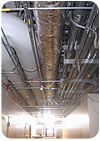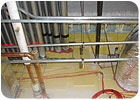A woman spent $2 million building an exact replica of her home, minus the roof, in a huge warehouse. When it came time to build the actual house, she insisted that it be built without the roof. A tent was erected and the roofless home was finished and the roof installed last. Her reason? She told the builder she wanted her house built exactly like the replica.
I would imagine the reason for building a $2 million replica home and installing $3 million worth of landscaping before adding water are illogical efforts to maximize quality or to achieve perfection?
MISSION STATEMENTS
Many general contractors and subcontractors today create what are called mission statements, which are simply principles to guide a company. A typical mission statement would go something like this:“Our mission is to provide the highest quality of construction to our customers while serving our highly valued employees and community.”
The word “quality” is often included in company mission statements because owners of companies believe the word is important to have in a mission statement. A mission statement is supposed to be something much more important than a collection of “buzzwords.” A mission statement is supposed to be something a company will not deviate from. It’s like a contract that everyone in the company is obligated to fulfill; however, mission statements are rarely fulfilled because profit is a higher priority. A more realistic mission statement would look like this:
“Our ultimate mission is to be highly profitable and to serve the needs of our stockholders, employees and community.”
I have a difficult time believing mission statements that include words like “quality,” “care,” “service,” “respect,” “honor” and “family,” because I don’t see these principles as the ultimate priority in most companies. The word “quality” is thrown around in mission statements, contracts, company names and conversation without sincerity or belief. For most, it’s a buzzword that people like to hear.

WHAT DRIVES A JOB?
The bid process is based on selecting contractors who have the lowest price and not the highest quality. Although a certain level of quality (industry standard) is expected from the lowest bidder, you can be sure that contracts are rarely awarded based on quality.Construction schedules are not designed to ensure the highest quality, but rather to be the most profitable in terms of money and time. Schedules are created by the lowest-priced general contractor who knows they must get the job done as fast as possible to maximize profit. Price and schedule often drive the job rather than a commitment to the highest quality.
Owners more often consider a construction company’s ability and resources than quality or price, especially when the project is large and complicated. Again, there is an expectation of quality; however, jobs are driven by price, schedule and ability rather than by quality.
When you read a GC’s mission statement and you read that “Quality is Job 1,” don’t put a lot of faith in their commitment to quality because quality is not what drives a job.

PROPER SEQUENCE
For the wall and ceiling contractor, the key to high quality and profitability is the sequence in which work is done. Subcontractors should not create mission statements emphasizing quality because subs have little control over the overall quality of a building unless it is built utilizing a reasonable schedule and proper sequence.What is a reasonable schedule and proper sequence? A reasonable schedule can be created with subcontractor input allowing the subcontractor enough time to perform his work while maximizing quality and profitability. The sequence of the work is the order in which it is performed and proper sequence is the key to maximizing wall and ceiling contractors’ profitability.
The best example I can offer is the proper sequence of building full-height sound- or fire-rated walls where framing and drywall run full height to (structure) the floor or roof. The most critical part of rated partitions is the “top of the wall.” The term “top of wall” refers to the area just above ceiling height and where the very top of the wall terminates against the floor above or the roof. As you know, the area between the ceiling and the floor or roof above is where sprinkler pipes, plumbing pipes, ductwork, cable trays and overhead electrical, known collectively as MEP trades, are concealed from view.
General contractors more often than not allow piping and ductwork to be installed before the wall and ceiling contractor installs full height drywall, sound caulking and fire stopping at top of wall. The result of the MEP trades going ahead of the drywall contractor is as illogical as installing a sprinkler system after landscape is done or building a house without a roof.
Cutting drywall around masses of pipes, ducts and electrical conduits is illogical, laborious, and above all degrades the quality of the wall. As well, fire stopping and sound caulking the tops of walls cannot be done effectively or productively with masses of MEP work in the way.
Fire-rated walls are designed to control fire while protecting people and rescue workers in the event of a fire. The top of a fire-rated wall must be sheetrocked, fire taped and fire stopped before MEP trades install work that would interfere with the quality and integrity of a fire rated wall.
I believe there are miles and miles of fire- and sound-rated walls whose quality and integrity have been degraded by being installed out of sequence, meaning after the MEP trades. In most of these cases, the top of wall drywall looks like a 10,000-piece puzzle and if you could see above all the ductwork and pipes, the very top of the wall will not be fire stopped or sound caulked because the area was either out of reach or buried.
Another name for sound and firewalls is “critical walls,” because they are life safety walls or walls that control sound transmission. The quality of a critical wall should never be degraded for any reason whatsoever; however, GCs regularly sequence the work incorrectly resulting in a degraded fire or sound rating which could become a serious liability for the wall and ceiling contractor if there is a serious enough loss of property or the loss of life, including rescue workers.
TRUE QUALITY
A rated wall should be built in the following way. First, the framing is installed from floor to structure, leaving a deflection joint if required. Second, the drywall should be installed on each side of the wall from the top of the wall down to just above ceiling height. Third, the drywall is fire taped, fire stopped or sound caulked. At this point, you should be able to look up at the top of the wall and see full sheets of drywall with taped butt joints and top of wall fire stopping or sound caulking complete.At this point, the MEP trades may proceed with their work while the drywall contractor assists the MEP trades in cutting large openings in the tops of walls or assisting in cutting drywall for the connecting of supply and waste lines.
Following this procedure will result in high-quality rated wall construction that you can be proud of. As well, you can ask any inspector, consultant or fire marshal to inspect your work without fear or concern. Lastly, in the event of a fire, you can be sure that your work was done properly.
WALL AND CEILING CONTRACTORS
It is the wall and ceiling contractor’s responsibility to inform and motivate CGs to follow proper sequences in order for us to achieve high-quality, profitable jobs. None of us want to defend a lawsuit involving sound transmission or fire ratings or, worse yet, a lawsuit for loss of life or property.I believe the best way to force the top of wall issue is by doing one or all of the following:
• Base your proposal on installing top of wall drywall, fire stop and or sound caulk prior to MEP trades installing their work.
• Make sure your contract is written to include language that allows you to go first.
• Have a pre-construction meeting and explain in detail why you must go first.
• If you have done the first three items, yet the GC allows the MEP trades to go first, don’t start your work until the MEP items are removed.
• Explain that rated walls are life safety and sound transmission issues which you will not be responsible for if forced to proceed out of sequence and that your productivity will be greatly impacted. Put this in writing.
MISSION STATEMENTS REVISITED
GCs who create fancy yet meaningless buzzword mission statements referring to “highest quality” or “quality” projects don’t really mean what they say. If they did mean what their mission statements said, wall and ceiling contractors would not have to debate scheduling and proper sequence or other things like weather protection and heat. Most GCs consider the word “quality” as something someone else is responsible for and rarely realize that “quality” is achieved by creating schedules and sequences that are conducive to achieving “quality” results.GCs who don’t see the value in proper sequencing and scheduling are not interested in quality. They may want it, but will quickly change their tune in order to manage their own risk. Always remember that in most cases you are working for the low bidder and the low bidder’s priorities may be different than yours.
On the first page of this column are two pictures of "top of wall" conditions. Picture “A” shows the difficulty of having to install drywall-fire stopping- sound caulking after the MEP trades have installed their work.
Picture “B” shows how the top of wall should look when done in the proper sequence. Notice that drywall is not cut into a million pieces. These are full sheets of drywall put up before MEP installations. Notice how pipe holes, etc. were cut in the sheet rock after our work was installed and notice the neatness of the fire stopping.
Remember: Teamwork begins with a fair contract!





